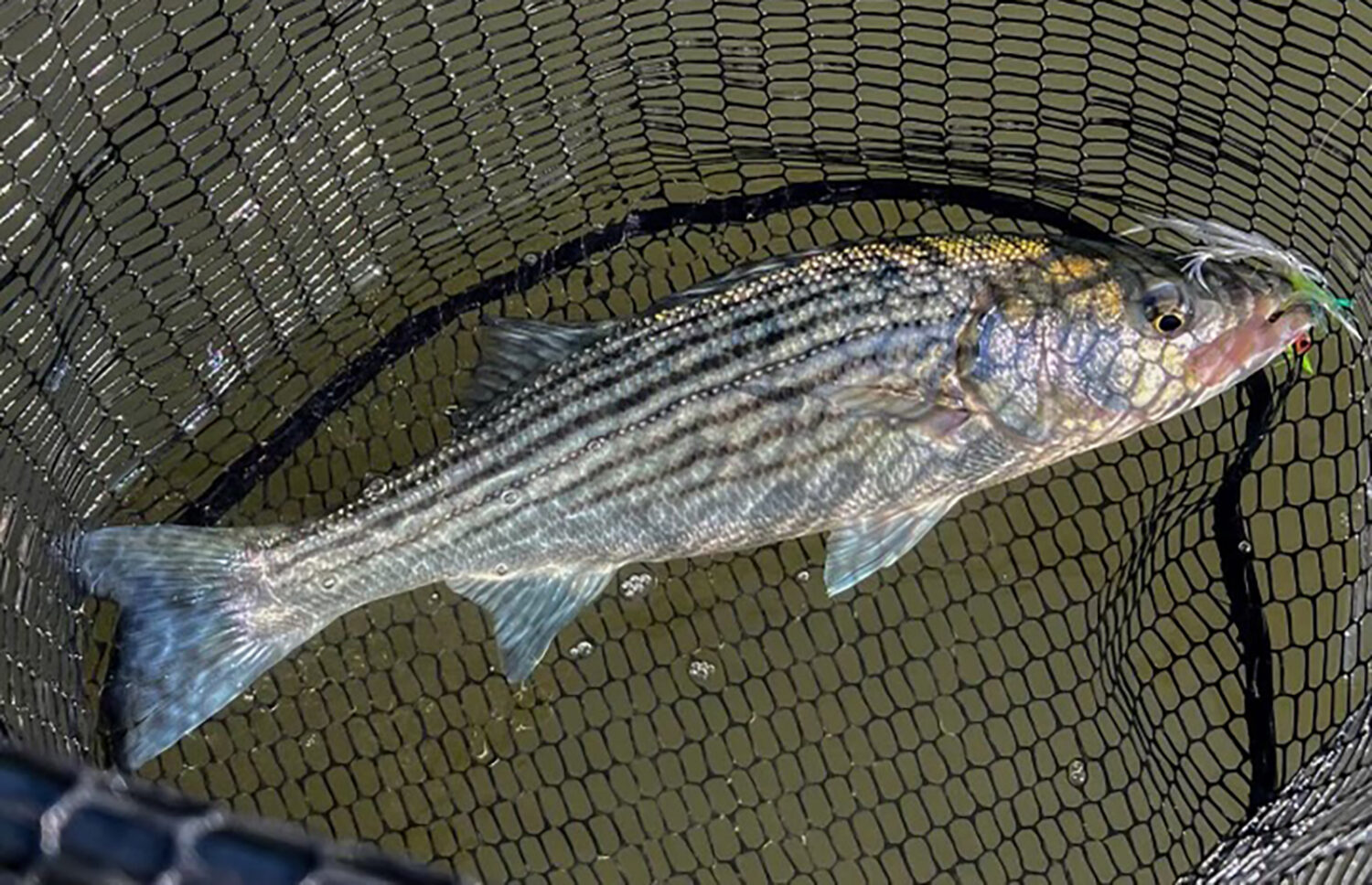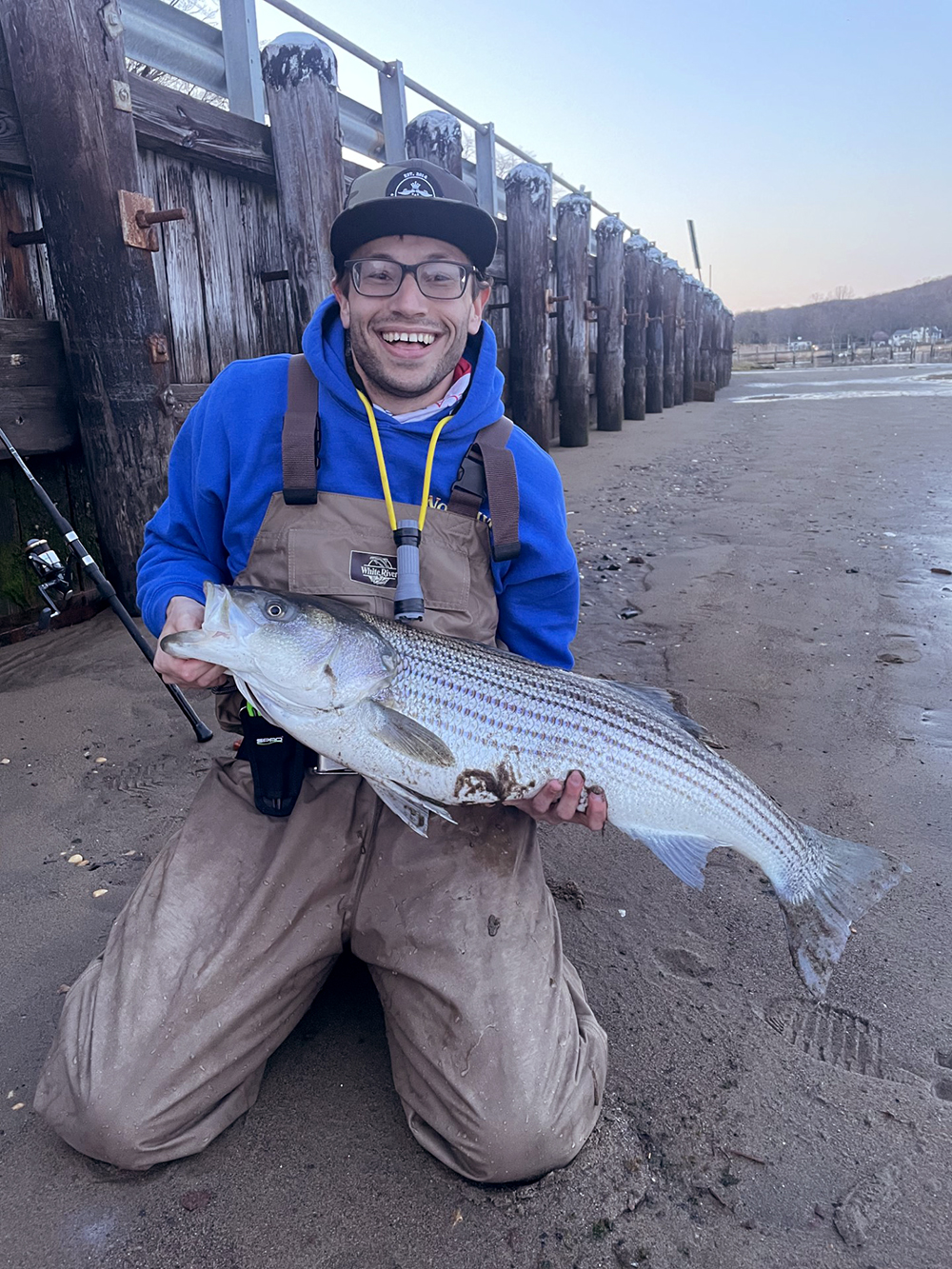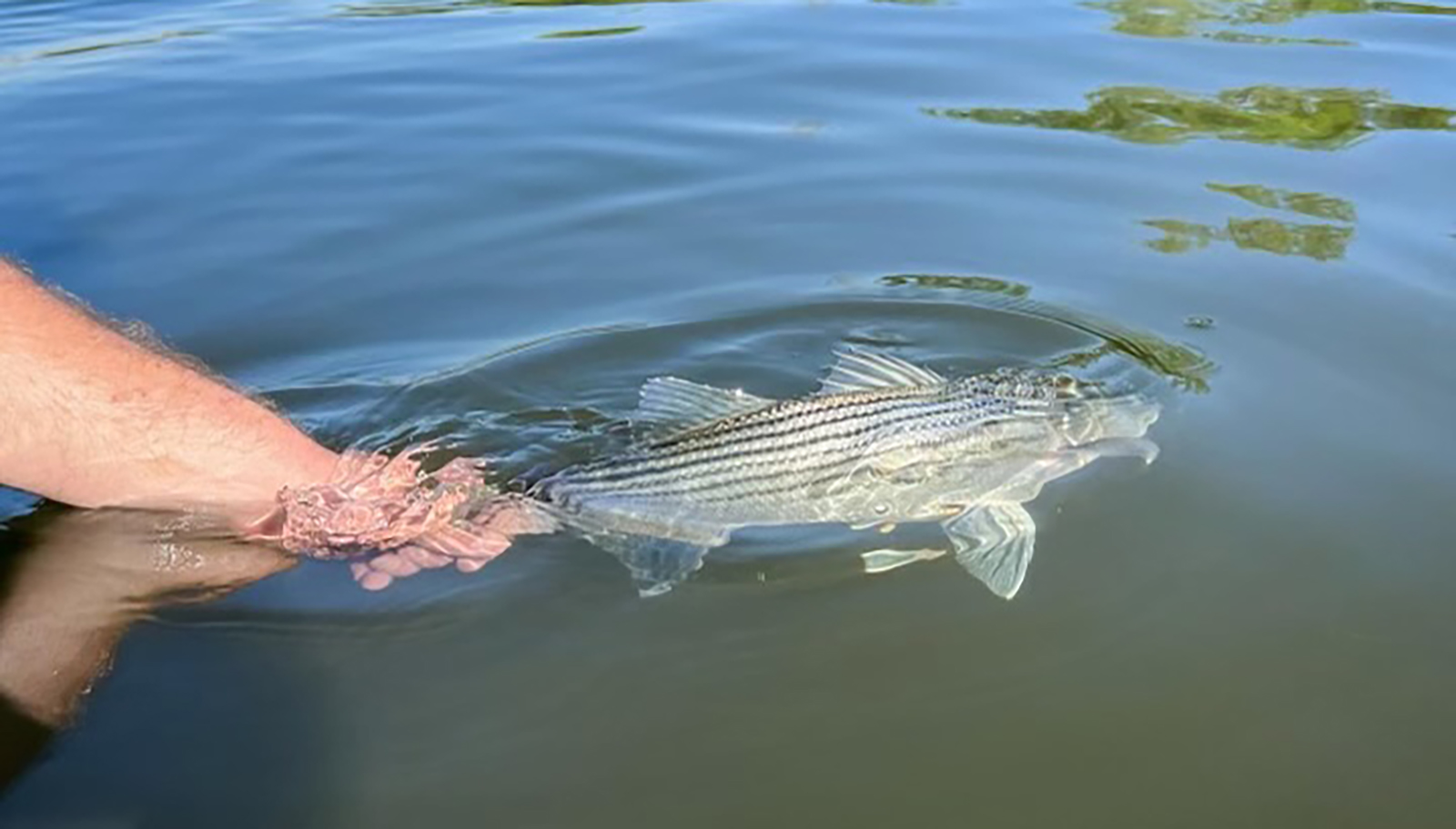By Alex McCrickard/DWR
It’s easy to understand why striped bass (Morone saxatilis) are known as “everyman’s fish.” They’re fun to catch and are one of the most accessible fish for anglers to target. Add on the variety of different methods you can use to successfully catch striped bass—live bait, trolling, bottom fishing, artificial lures, and fly fishing—it’s easy to understand why they are referred to as “everyman’s fish.”
Migratory, marine striped bass in Virginia (those in the Chesapeake Bay, its tidal tributaries, and along the Atlantic Coast) are managed by the Virginia Marine Resources Commission (VMRC) in collaboration with the Atlantic States Marine Fisheries Commission (ASMFC). In addition to the migratory striped bass stock, Virginia boasts some of the best inland, land-locked striped bass opportunities you can find in the east in lakes and reservoirs that are managed by the Virginia Department of Wildlife Resources (DWR).
Whether you are fishing in fresh or saltwater, striped bass are incredibly popular in the culinary industry. In fact, all of our inland striped bass fisheries in Virginia are managed for some level of angler harvest. Eating a fish that you have just caught on rod and reel can be one of the most satisfying accomplishments an angler can have. However, many anglers prefer to practice catch and release to promote conservation of the resource. Catch and release is even required by regulations in many instances if the fish you have caught does not meet a slot or minimum length requirement or perhaps you have already caught your limit.
What the Science Says
The best available science shows us that catch-and-release mortality averages 9 percent for striped bass fisheries. This means that on average, 9 percent of striped bass that are released after being caught succumb to post-release mortality.
Some of the major variables that influence catch-and-release mortality include air temperature, water temperature, dissolved oxygen concentrations, and salinity. Studies have shown that in cold water with high salinity levels, such as the lower Chesapeake Bay in December and January, when water temperatures are between 40 and 45 degrees Fahrenheit, that percentage drops significantly.
Conversely, studies have shown that when water temperatures exceed 70 degrees Fahrenheit and its entirely freshwater, such as the James River in Richmond in late May and June or an inland Virginia striped bass reservoir in the summer months, that percentage increases significantly above 9 percent. Water temperature is a major driver for dissolved oxygen concentrations. Colder water with higher concentrations of dissolved oxygen improves striped bass catch-and-release success. In warm water scenarios with lower concentrations of dissolved oxygen, stressed striped bass are at higher risk of succumbing to post-release mortality.
Many anglers fishing for striped bass during the summer months in Virginia’s reservoirs focus on catching their limit of striped bass and then either quit fishing or focus on other species such as largemouth bass. “A no-cull ethic during the warm, summer months is essential to reduce mortality due to handling stress when water temperatures are high,” said Dan Michaelson, DWR fisheries biologist. “Impoundments like Smith Mountain Lake and Buggs Island Lake even have different harvest regulations during the summer months to encourage anglers to keep the first few striped bass they catch and then quit for the day.”
VMRC Regulation Updates
Additionally, with the Atlantic striped bass stock currently considered “overfished” by the Atlantic States Marine Fisheries Commission (ASMFC), catch and release is being more heavily embraced by striped bass anglers for conservation and even required in a lot of instances, with tighter slot limits coastwide.
“On May 2, 2023, the ASMFC Striped Bass Management Board approved by emergency action a 31-inch maximum size to all existing recreational fishery regulations where a higher (or no) maximum size limit applies,” said Josh McGilly, fisheries management scientist for VMRC. “The Virginia Commission will hear this emergency action at their June 27 meeting and will go into effect once voted on. The new maximum recreational size limit for striped bass for the Virginia Coastal season, Chesapeake Bay fall season, and the Potomac River tributaries summer/fall season will change from 36 inches to 31 inches; this action does not change possession limits, seasons, gear restrictions, and spawning protections already in place for the 2023 fishing year. This emergency action was done in response to the increased 2022 recreational harvest being almost double that of the 2021 fishing year. The new 31-inch maximum size limit was chosen to protect the strong 2015-year class,” McGilly explained.
Catch and Release Best Practices
Whether you are fishing for inland reservoir striped bass or the Chesapeake Bay and its tributaries for anadromous striped bass, following these best practices can help to conserve our striped bass fisheries for the future when practicing catch and release.
- Avoid fighting striped bass to exhaustion. Make sure you have a heavy enough rod and associated tackle to land the fish relatively quickly, especially if you are targeting trophy-sized striped bass.
- A large rubber net can be beneficial when landing striped bass. This will allow you to keep the fish wet while you prepare to remove the lure, fly, or hook. This also allows you to keep the fish wet if you’re preparing to take photos.

Using a soft rubber net will help keep striped bass wet when preparing to remove the hook or fly. Photo by Meghan Marchetti/DWR
- Always wet your hands before handling striped bass and never handle them with dry hands. Handling any fish with dry hands can take the protective slime coating off, making them more susceptible to bacteria, parasites, and other pathogens.
- When photographing the fish out of the water, keep it quick to minimize air exposure and get the fish back into the water as soon as you can. Always support the weight of the fish with two hands and avoid a vertical hold on striped bass. Gripping the fish by the lower jaw while supporting the weight of the fish by holding it under the belly is best.

VMRC’s Josh McGilly with a striped bass he caught in the surf. It’s best to support the weight of a striped bass with two hands when photographing before releasing.
- You don’t have to take photos of every single striped bass you catch. Consider taking photos of particularly memorable fish on each trip in order to release the majority of the fish you land quickly.
- Avoid having striped bass make contact with boat surfaces such as carpet and metal when handling. When bank fishing on rivers or beaches, avoid having striped bass make contact with rocks and sand along the bank. If the fish has to be on the ground for a brief period of time, make sure its on a wet surface such as wet sand instead of dry sand.
- Make sure you have a pair of long pliers, such as needlenose, for unhooking fish, especially for those fish that are hooked in hard-to-reach places. Dehooking devices can also be beneficial in these scenarios.
- If the hook is too deep, it is best to cut the line as close to the hook eye as you can. Most non-stainless hooks will rust out and dissolve over time, which will give the fish a much better chance of survival than the stress that comes with attempting to remove the hook with pliers.
- When handling striped bass out of the water, make sure to keep your hands and fingers away from the gills and gill arches. Don’t hold the fish too tightly and never hold a fish by the eyeball sockets.
- When releasing striped bass, it’s important to let the fish recover on its own terms; the fish will swim out of your hands when it’s ready. Avoid tossing the fish back into the water as lactic acid builds up in the muscles during the fight, especially for larger fish. To help revive the fish, it is best to hold the fish upright and move the fish gently forward so water runs over the gills. When fishing in tidal water, rivers, and moving water, always face a fish upstream or against the current during a release.

When releasing striped bass, it’s best to face them against the current and let them recover on their own terms. They will swim out of your hands when they are revived and ready. Photo by Meghan Marchetti/DWR
- Consider using barbless hooks and single-point hooks instead of treble hooks.
- Use non-offset (inline) corrodible circle hooks when fishing for striped bass with bait. This is required by regulation when fishing for striped bass with live or chunk bait in brackish waters in Virginia. DWR strongly encourages the use of circle hooks for striped bass in Virginia’s inland reservoirs. Studies show that circle hooks prevent gut hooking and improve your chances of a successful release.

Images courtesy of VMRC
For questions concerning marine striped bass in Virginia you can contact Josh McGilly, fisheries management scientist for the Virginia Marine Resources Commission.
- Joshua.McGilly@mrc.virginia.gov
- 757-247-2299
For questions concerning inland striped bass in Virginia you can contact the Department of Wildlife Resources
- fisheries@dwr.virginia.gov
- 804-367-1000

